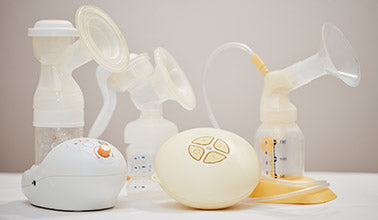Most people select their breast pump while pregnant. Before beginning the selection process, it’s important to take some time to determine what your breastfeeding goals are to evaluate your specific needs, and narrow down which options may be best for you. To begin, you should ask yourself a few questions:
- Are you planning to exclusively pump?
- Are you planning to primarily nurse and supplement with pumped breast milk?
- Is portability important for you (i.e. being able to move around freely while pumping) or will you have a designated pumping location (home or office)?
- What will your insurance cover and what is within your budget?
Breast Pump Categories
Our bodies are unique and there are many breast pumps on the market. Therefore, it is important to figure out what pump you’ll respond best to and what pump will fit seamlessly into your lifestyle. To categorize and describe the different types of breast pumps, I like to divide them into two major categories based on their power and efficiency. First, we’ll discuss primary pumps, which are known for being more powerful and efficient. Then we’ll discuss secondary breast pumps which have smaller, less powerful motors and may not be as efficient. By understanding these categories, you can better select a breast pump that will help you achieve your breastfeeding goals.
Primary Pumps
A primary breast pump is used for establishing, maintaining, and increasing milk supply when your baby is either not directly nursing or not adequately removing milk while at the breast. Primary pumps are not only powerful breast pumps, but they also have a long motor life which means they are durable enough to be used many times per day throughout your breastfeeding journey and have options to customize settings for vacuum, speed, and mode. To understand what these different settings mean, read 5 Things to Know About Pumping.
Double electric personal use breast pumps are often powerful enough to be your go-to choice for pumping. However, there may be some instances when your lactation consultant suggests using a hospital grade breast pump. For instance, if your baby needs special care in the NICU or you are experiencing low milk supply, you may benefit from the slight increase in power that a hospital grade pump offers. Hospitals usually provide access to these pumps during your stay, and they’re also available to rent as needed. Let your lactation consultant be your guide, helping you figure out which pump suits you best on your breastfeeding journey.
Secondary Pumps
Secondary breast pumps are all about convenience–they’re designed to be quick, easy, and discreet for on-the-go pumping. Secondary pumps tend to be less powerful, may sit differently on the breast compared to traditional flanges, and many people report they do not drain the breasts as well as their primary pump.
Wearable pumps
Wearable pumps are a favorite among breastfeeding moms for their convenience and discretion. These compact devices slip seamlessly into your bra, allowing you to pump discreetly while staying covered. While they may not be as effective as primary pumps at removing milk, they can still be a great option depending on your breastfeeding goals. If you primarily nurse but need occasional pumping sessions, a wearable pump might suit your needs perfectly without impacting your milk supply. However, if you're focused on establishing your milk supply or exclusively pumping, you may want to opt for a more efficient pump for most sessions.
Silicone pumps
Silicone breast pumps have become increasingly popular because of their simplicity and effectiveness. This pump applies constant suction to the breast and the suction level is adjusted by how tightly you compress the pump before applying it. Many people like to place the silicone pump on one breast while nursing their baby from the other. Since it does apply suction to the breast, it will be actively removing milk during a milk let down, which will likely extract more milk than you would naturally leak from one breast.
It is crucial to use silicone pumps in moderation with appropriate suction strength to avoid issues such as oversupply, swelling, and nipple soreness.
Manual (hand) pumps
Manual pumps are hand operated, giving you complete control of the speed and strength of your pump. These are sold individually, and most people pump one side at a time. Manual pumps are great to have for occasional use or as a backup to your double electric breast pump because they are portable, quiet, and discreet.
Understanding insurance coverage
Many insurance plans in the US offer either full or partial coverage for breast pumps. Take the time to understand your insurance benefits by calling the number on your insurance card and speaking to a representative. Navigating the insurance process can be daunting, but your insurance provider can get you started by advising you which durable medical equipment company they work with, how much of the cost your insurance will cover, and if they are able to cover or reimburse you for replacement pump parts and milk storage bags.
Final thoughts
Selecting a breast pump takes careful consideration. After determining your breastfeeding goals, you can find a pump that aligns with these goals and your lifestyle. There are so many different pumps on the market and it’s important to remember that there’s not one single breast pump that works best for everyone. By working with your healthcare team and your insurance provider, you can navigate this process with confidence and find the ideal breast pump to support your breastfeeding journey.
This site is intended for informational purposes only and does not provide medical advice. Please consult your physician or other health-care professional.
